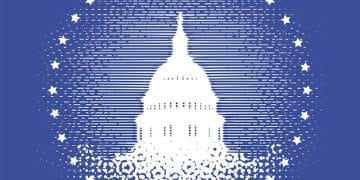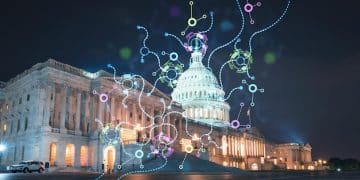Social Media’s Impact: US Politics & Society Explained

Advertisements
Social media platforms have profoundly reshaped US politics and society by amplifying polarization, disseminating misinformation, and altering civic engagement, necessitating comprehensive regulatory and educational countermeasures.
Advertisements
In an increasingly digital world, the profound influence of social media on the fabric of American democracy and daily life is undeniable. Understanding the multifaceted challenges and opportunities arising from the impact of social media on US politics and society: what can be done? is crucial for fostering a more informed and resilient public sphere.
The Evolution of Social Media’s Political Role
Social media platforms began as tools for connection, yet their evolution saw them rapidly transform into potent forces in the political arena. Early days saw them as avenues for grassroots organizing and disseminating unfiltered information, offering a direct line for politicians to constituents and for citizens to engage with political discourse.
Advertisements
However, this initial promise quickly gave way to a more complex reality. The sheer volume of information, coupled with algorithms designed to maximize engagement, created echo chambers and filter bubbles. These digital enclosures meant users were increasingly exposed only to viewpoints corroborating their own, inadvertently fostering ideological segregation rather than open debate. This shift laid the groundwork for many of the challenges observed today.
From Connection to Polarization
The transition from a mere communication tool to a driver of political polarization is a significant development. While traditional media also had biases, social media’s scale and algorithmic nature amplified these effects, making it harder for individuals to encounter diverse perspectives. This has led to a more fragmented public discourse.
- Echo Chambers: Algorithms prioritize content aligning with past preferences, reinforcing existing beliefs.
- Filter Bubbles: Users are insulated from opposing viewpoints, reducing exposure to dissenting arguments.
- Ideological Separation: Online interactions frequently harden political lines, diminishing common ground.
The speed at which information (and often misinformation) spreads on these platforms further exacerbates this issue. A narrative, whether factual or not, can gain immense traction before traditional fact-checking mechanisms can respond, shaping public opinion in real-time. This dynamic has made discerning reliable information a significant challenge for the average user, contributing to a sense of distrust in established institutions.
In essence, social media’s political role has matured from a simple conduit to a complex ecosystem. It now actively shapes political narratives, influences public perception, and, at times, directly impacts electoral outcomes. This evolving role necessitates a deeper examination of its inherent mechanisms and their societal repercussions.
Misinformation and Disinformation: A Digital Plague
The spread of misinformation and disinformation represents one of the most insidious consequences of social media’s proliferation. Misinformation, often spread unintentionally, refers to incorrect or misleading information. Disinformation, on the other hand, is deliberately false content created to deceive, often with specific political or ideological aims.
Both types thrive in the rapid, low-friction environment of social media. Viral content, sensational headlines, and emotionally charged narratives bypass critical thinking, leading to widespread adoption of fallacies. This phenomenon profoundly threatens democratic processes by eroding trust in facts, institutions, and even the electoral system itself. The challenge is magnified by foreign state actors and domestic groups leveraging these platforms to influence public opinion.

How Falsehoods Go Viral
The virality of falsehoods is not accidental but integral to platform design. Algorithms favor emotionally resonant content, which often includes sensational or conspiratorial narratives. These narratives are frequently shared without scrutiny, reaching vast audiences. The anonymity afforded by online interactions can also lower inhibitions, making users more likely to share unverified claims.
- Algorithmic Amplification: Content sparking high engagement gets greater visibility, even if false.
- Emotional Resonance: Falsehoods often tap into strong emotions, making them highly shareable.
- Confirmation Bias: Users are more likely to believe and share information that confirms existing biases.
The speed and reach of social media mean that a piece of disinformation can embed itself in public consciousness before any effective counter-narrative can be established. This creates a challenging environment for journalists and educators trying to disseminate accurate information, as they are often playing catch-up to emotionally persuasive, yet factually incorrect, content.
The deliberate creation and dissemination of disinformation, particularly by bad actors, also poses a significant national security concern. These campaigns aim to sow discord, undermine public trust, and influence elections, often exploiting existing societal divisions. Addressing this digital plague requires a multi-faceted approach involving platforms, governments, and individual users alike, recognizing the complex interplay between technology, human psychology, and political objectives.
Civic Engagement and Political Participation in the Digital Age
While often criticized for its negative impacts, social media has undeniably revolutionized civic engagement and political participation. It has democratized access to political discourse, allowing ordinary citizens to voice opinions, organize movements, and hold leaders accountable in ways previously unimaginable. Hashtag activism, online petitions, and live streams of protests exemplify this new era of digital participation.
Social media has lowered the barrier to entry for political activity, enabling rapid mobilization for causes ranging from local community issues to national political movements. This ease of participation can empower marginalized groups and amplify voices that might otherwise go unheard, fostering a sense of collective agency. However, the nature of this engagement is not without its complexities, balancing genuine participation with superficial “slacktivism.”
New Forms of Political Activism
The digital landscape has given rise to novel forms of political engagement. Campaigns can now reach voters directly, bypassing traditional media gatekeepers. Online fundraising has become a powerful tool, enabling small-dollar donations to fuel major political campaigns. Furthermore, social media platforms have fostered unprecedented opportunities for direct communication between constituents and their elected representatives, theoretically increasing accountability.
- Direct Communication: Politicians can engage voters instantly, fostering perceived accessibility.
- Grassroots Mobilization: Social media facilitates rapid organization for protests and campaigns.
- Issue Awareness: Niche issues gain broader visibility and support through online discussions.
Yet, the effectiveness of online engagement is often debated. Skeptics argue that while it can raise awareness, it may not always translate into tangible off-line action or sustained civic responsibility. The ephemeral nature of online trends and the prevalence of “call-out culture” can also lead to superficial engagement rather than deep, meaningful civic participation.
Despite these caveats, social media’s role in civic life remains transformative. It has fundamentally altered how political campaigns are run, how news is consumed, and how citizens interact with their government. Understanding and harnessing the positive aspects of this digital connectivity, while mitigating its drawbacks, is key to fostering a healthier, more participatory democracy in the 21st century.
The Regulatory Landscape: Challenges and Debates
The significant impact of social media on US politics and society has inevitably led to calls for greater regulation. However, navigating this regulatory landscape is fraught with complex challenges and heated debates, primarily due to First Amendment concerns and the rapidly evolving nature of technology. Lawmakers grapple with questions of platform responsibility, data privacy, content moderation, and algorithmic transparency.
The core tension lies between safeguarding free speech and curbing harmful content, such as disinformation, hate speech, and incitement to violence. Different approaches are debated, from stricter moderation requirements to antitrust measures aimed at breaking up tech monopolies. The lack of a unified, comprehensive regulatory framework reflects the deep divisions in how to best manage these powerful digital entities.
Balancing Free Speech and Harm Reduction
Striking the right balance between protecting constitutionally guaranteed free speech and mitigating the societal harms propagated on social media is a monumental task. Critics argue that platforms have become too powerful in curating public discourse, while others contend they are not doing enough to remove dangerous content. The “Section 230” of the Communications Decency Act, which protects platforms from liability for content posted by users, is central to this debate, with calls for its reform or repeal.
- Content Moderation: Debates center on who should decide what content is permissible and how.
- Section 230 Reform: Calls to alter the law that shields platforms from liability for user content.
- Data Privacy: Concerns over how user data is collected, used, and protected by platforms.
Another major challenge involves the global nature of these platforms versus the national scope of regulatory efforts. Laws enacted in the US may have limited impact on platforms headquartered elsewhere, or on content originating from foreign actors. This necessitates international cooperation, which is often difficult to achieve given differing legal and cultural norms.
Moreover, the technological complexity of social media platforms makes enforcement difficult. Algorithms are constantly changing, and identifying harmful content at scale requires sophisticated tools and a deep understanding of evolving online behaviors. As such, the regulatory landscape is in a constant state of flux, with lawmakers struggling to keep pace with innovation while addressing urgent societal concerns.
Strategies for Mitigation: What Can Be Done?
Addressing the complex challenges posed by social media requires a multi-pronged strategy involving various stakeholders. No single solution will suffice, but a combination of regulatory action, technological innovation, media literacy education, and renewed civic responsibility holds promise. The goal is not to eliminate social media, but to foster an environment where its benefits are maximized while its harms are minimized.
Governments, tech companies, educational institutions, and individuals all have a role to play. Incremental changes across these sectors can collectively contribute to a more resilient information ecosystem and a healthier political discourse. This involves moving beyond reactive measures to proactive long-term solutions that promote critical thinking and foster a more informed citizenry.
A Multi-Faceted Approach to a Healthier Digital Sphere
Firstly, stricter, yet judicious, regulation is necessary. This could include mandates for greater algorithmic transparency, robust data privacy protections, and clear guidelines for content moderation that are consistently applied. Such regulations would hold platforms more accountable for the content they host and amplify.
- Algorithmic Transparency: Requiring platforms to reveal how their algorithms prioritize content.
- Enhanced Media Literacy: Educating citizens, especially youth, on how to critically evaluate online information.
- Platform Accountability: Holding social media companies responsible for the spread of harmful content.
Secondly, investing in media literacy education is paramount. Equipping citizens with the skills to identify misinformation, understand persuasive techniques, and critically evaluate diverse sources of information can build individual resilience against manipulation. This should start in schools and extend into public awareness campaigns.
Thirdly, platforms themselves must commit to ethical design. This means prioritizing user well-being over engagement metrics that often amplify sensationalism. Features like clear labeling of AI-generated content, fact-checking partnerships, and design choices that reduce virality of unverified claims can make a significant difference. Regular independent audits of their practices could also ensure compliance and foster trust.
Finally, fostering greater civic responsibility among users is crucial. Encouraging thoughtful engagement, promoting respectful debate, and discouraging the spread of unverified information can individually and collectively contribute to a healthier digital public square. This collective effort is instrumental in shaping a future where social media serves as a tool for progress rather than division.
The Future Landscape: Predictions and Possibilities
Looking ahead, the future landscape of social media’s interaction with US politics and society is likely to be characterized by continued evolution and increasing complexity. As technology advances, new challenges and opportunities will emerge, necessitating adaptive strategies from all stakeholders. Artificial intelligence, virtual reality, and decentralized social networks are just some of the innovations poised to reshape the digital sphere.
The ongoing debates around regulation, societal impact, and technological development will intensify. We might see a bifurcation of platforms, with some prioritizing free speech and others focusing on heavily moderated, curated environments. The influence of global events and geopolitical tensions will also continue to ripple through online spaces, adding layers of complexity to domestic political discourse.

Emerging Technologies and Their Implications
The rise of advanced AI models presents both immense promise and significant peril. While AI can assist in content moderation and fact-checking, it also enables the creation of sophisticated deepfakes and highly personalized disinformation campaigns, making it harder to distinguish reality from fabrication. The arms race between those spreading falsehoods and those fighting them will likely escalate.
- AI-Generated Content: Deepfakes and synthetic media will complicate truth discernment.
- Decentralized Networks: Could offer alternatives to centralized platforms, but also new moderation challenges.
- Metaverse Politics: Virtual worlds may become new arenas for political organizing and influence.
Furthermore, the concept of the “metaverse” and more immersive digital environments could introduce new dimensions to political campaigning and social interaction. Questions of identity, ownership, and governance within these virtual spaces will become increasingly relevant. Decentralized social networks, built on blockchain technology, might offer alternatives to the current dominant platforms, promising greater user control but potentially complicating moderation efforts.
The political polarization fueled by social media is unlikely to dissipate quickly, but increased awareness and proactive measures could mitigate its most harmful effects. The potential for social media to be a force for positive change, facilitating civic engagement and direct communication, remains a powerful possibility. The coming years will likely be defined by a concerted effort to harness this potential while navigating the ever-present risks, requiring continuous dialogue and collaboration among policymakers, tech innovators, and the public.
Case Studies: Social Media’s Influence in Recent Elections
Examining recent US elections provides concrete examples of social media’s profound influence on political outcomes. From the 2016 presidential election onwards, these platforms have served as battlegrounds for narratives, arenas for mobilization, and conduits for both legitimate political discourse and foreign interference. Understanding these case studies helps illustrate the theories discussed earlier in practice.
The unprecedented reach and targeting capabilities of social media advertising allowed campaigns to micro-target voters with specific messages, bypassing traditional media filters. This personalized approach, while effective, also raised concerns about privacy and the potential for manipulative messaging that exploited individual vulnerabilities. The speed of information dissemination and the virality of emotionally charged content also played pivotal roles in shaping public opinion in critical moments.
Key Examples and Their Lessons
The 2016 election highlighted concerns around disinformation, with foreign actors leveraging platforms to sow discord and influence voter perceptions. Post-election analyses revealed how sophisticated, coordinated campaigns exploited social media’s algorithmic amplification to spread false narratives, demonstrating the vulnerability of the information ecosystem.
- 2016 Election Interference: Demonstrated vulnerabilities to foreign influence campaigns and disinformation.
- 2020 Election Narrative Control: Platforms faced immense pressure to moderate election-related content and combat widespread falsehoods.
- 2022 Midterms and Local Impacts: Showed how social media mobilizes grassroots efforts and amplifies local issues.
In the 2020 election, the focus shifted to domestic misinformation and the platforms’ responsibility in moderating content, particularly concerning election integrity. Social media companies faced immense pressure to implement stricter fact-checking and remove content deemed to incite violence or undermine democratic processes, leading to debates about censorship and free speech.
Subsequent elections, including the 2022 midterms, continued to show social media’s role in grassroots organizing, fundraising, and rapid response to political events. They also continued the trend of platforms grappling with the balance between enabling free political expression and combating harmful content. These cases underscore the ongoing challenge of managing social media’s power, illustrating that each election cycle presents new lessons and reinforces the need for adaptive strategies to protect democratic integrity in the digital age.
| Key Aspect | Brief Description |
|---|---|
| 📊 Polarization | Algorithms boost echo chambers, fostering ideological division in political discourse. |
| 🚫 Disinformation | False narratives spread rapidly, eroding trust in facts and democratic processes. |
| 🗣️ Civic Engagement | Platforms enable new forms of activism, mobilization, and direct politician-voter links. |
| ⚖️ Regulation | Debates ongoing regarding content moderation, data privacy, and platform accountability. |
Frequently Asked Questions
▼
Social media algorithms are primarily designed to maximize user engagement. They do this by showing users more of what they already like or agree with, creating “echo chambers” or “filter bubbles.” This reduces exposure to diverse viewpoints, reinforcing existing beliefs and making it harder for individuals to understand or empathize with opposing political perspectives, thereby deepening societal divides.
▼
Misinformation refers to incorrect or misleading information shared without intent to deceive. It’s often spread innocently. Disinformation, however, is deliberately false information created and disseminated with the intent to harm, mislead, or manipulate, often for political gain or to sow discord. Distinguishing between the two is crucial for understanding the intent behind false narratives.
▼
Social media transformed political campaigns by enabling direct communication with voters, bypassing traditional media. It facilitates micro-targeting, allowing campaigns to tailor messages to specific demographics. Crucially, it revolutionized fundraising, enabling small-dollar donations from a vast base of supporters, significantly reducing reliance on large donors and PACs, and empowering grassroots movements.
▼
Media literacy empowers citizens with the critical thinking skills needed to evaluate information encountered online. It helps individuals identify credible sources, recognize biases, understand persuasive techniques, and discern between factual content and propaganda or misinformation. By fostering informed consumption, media literacy is a vital defense against the manipulative aspects of social media, promoting a more discerning public.
▼
The US has limited direct regulation of social media content due to First Amendment protections. Section 230 shields platforms from liability for user-generated content, sparking ongoing debate about platform responsibility. While some regulations exist for political advertising, comprehensive frameworks addressing disinformation or algorithmic impact are largely absent or still evolving, presenting significant enforcement challenges amidst rapid technological change.
Conclusion
The impact of social media on US politics and society is a dynamic and multifaceted phenomenon. It has revolutionized civic engagement, democratizing access to political discourse and enabling rapid mobilization for diverse causes. Yet, it has also amplified polarization, facilitated the widespread dissemination of misinformation, and presented unprecedented challenges to the integrity of democratic processes. Moving forward, a cohesive strategy is essential, one that balances free speech principles with the urgent need for responsibility and factual accuracy. This involves a collaborative effort from policymakers implementing judicious regulations, tech companies committing to ethical design and transparent algorithms, educational institutions fostering robust media literacy, and individuals exercising greater civic responsibility in their online interactions. By navigating these complexities with foresight and commitment, society can strive to transform social media from a source of division into a powerful tool for informed discourse, genuine participation, and a healthier democratic future.





